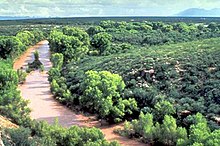
Back تلوث غير محدد المصدر Arabic Contaminació difusa Catalan Contaminación difusa Spanish Hajureostus Estonian آلودگی منبع غیرنقطهای Persian Gurbataccen yanayi Hausa 非特定汚染源負荷 Japanese Poluição difusa Portuguese Не-тачкасти извори загађења Serbian Неточкові джерела забруднення Ukrainian

| Part of a series on |
| Pollution |
|---|
 |
Nonpoint source (NPS) pollution refers to diffuse contamination (or pollution) of water or air that does not originate from a single discrete source. This type of pollution is often the cumulative effect of small amounts of contaminants gathered from a large area. It is in contrast to point source pollution which results from a single source. Nonpoint source pollution generally results from land runoff, precipitation, atmospheric deposition, drainage, seepage, or hydrological modification (rainfall and snowmelt) where tracing pollution back to a single source is difficult.[1] Nonpoint source water pollution affects a water body from sources such as polluted runoff from agricultural areas draining into a river, or wind-borne debris blowing out to sea. Nonpoint source air pollution affects air quality, from sources such as smokestacks or car tailpipes. Although these pollutants have originated from a point source, the long-range transport ability and multiple sources of the pollutant make it a nonpoint source of pollution; if the discharges were to occur to a body of water or into the atmosphere at a single location, the pollution would be single-point.
Nonpoint source water pollution may derive from many different sources with no specific solutions or changes to rectify the problem, making it difficult to regulate. Nonpoint source water pollution is difficult to control because it comes from the everyday activities of many different people, such as lawn fertilization, applying pesticides, road construction or building construction.[2] Controlling nonpoint source pollution requires improving the management of urban and suburban areas, agricultural operations, forestry operations and marinas.
Types of nonpoint source water pollution include sediment, nutrients, toxic contaminants and chemicals and pathogens. Principal sources of nonpoint source water pollution include: urban and suburban areas, agricultural operations, atmospheric inputs, highway runoff, forestry and mining operations, marinas and boating activities. In urban areas, contaminated storm water washed off of parking lots, roads and highways, called urban runoff, is usually included under the category of non-point sources (it can become a point source if it is channeled into storm drain systems and discharged through pipes to local surface waters). In agriculture, the leaching out of nitrogen compounds from fertilized agricultural lands is a nonpoint source water pollution.[3] Nutrient runoff in storm water from "sheet flow" over an agricultural field or a forest are also examples of non-point source pollution.
- ^ "Basic Information about Nonpoint Source Pollution". Washington, DC: US Environmental Protection Agency (EPA). 2020-10-07.
- ^ "Management Program for Nonpoint Source Water Pollution". Austin, TX: Texas Commission on Environmental Quality. 2017-08-22.
- ^ Moss, Brian (2008). "Water Pollution by Agriculture". Phil. Trans. R. Soc. Lond. B. 363 (1491): 659–666. doi:10.1098/rstb.2007.2176. PMC 2610176. PMID 17666391.